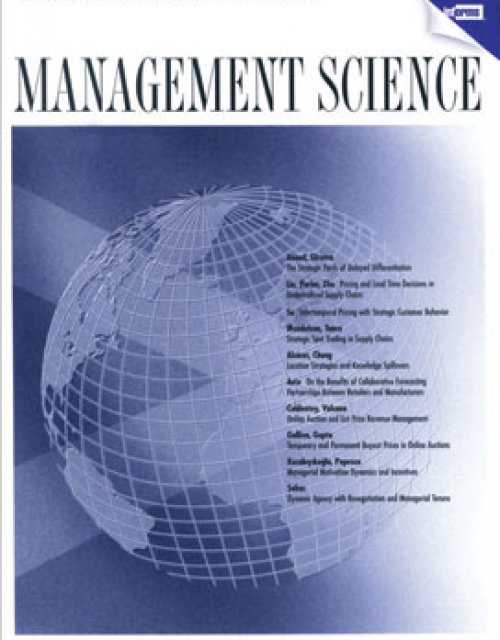Publication records
Subject(s)
Marketing
Keyword(s)
corporate social responsibility, stock risk, marketing-finance interface, advertising, research and development
Marketers and investors face a heated, provocative debate over whether excelling in social responsibility initiatives hurts or benefits firms financially. This study develops a theoretical framework that predicts (1) the impact of corporate social performance (CSP) on firm-idiosyncratic risk and (2) the role of two strategic marketing levers, advertising and research and development (R&D), in explaining the variability of this impact among different firms. The results show that higher CSP lowers undesirable firm-idiosyncratic risk. Notably, although the salutary impact of CSP is greater in firms with higher (versus lower) advertising, a simultaneous pursuit for CSP, advertising, and R&D is harmful with increased firm-idiosyncratic risk. For theory, the authors advance the literature on the marketing-finance interface by drawing attention to the risk-reduction potential of CSP and by shedding new light on some critical but neglected roles of strategic marketing levers. They also extend CSP research by moving away from the long-fought battle for a universal CSP impact and toward a finer-grained understanding of when some firms derive more risk-reduction benefits from CSP. For practice, the results indicate that the "goodwill refundßÂ" of CSP is not unconditional. They also empower marketers to communicate more effectively with investors (i.e., doing good to better manage the risk surrounding firm stock prices).
With the permission of the American Marketing Association
Volume
73
Journal Pages
198–213
Subject(s)
Marketing
Keyword(s)
utility-preference, estimation, theory, prospect theory, loss aversion
The silver lining effect predicts that segregating a small gain from a larger loss results in greater psychological value than does integrating them into a smaller loss. Using a generic prospect theory value function, we formalize this effect and derive conditions under which it should occur. We show analytically that if the gain is smaller than a certain threshold, segregation is optimal. This threshold increases with the size of the loss and decreases with the degree of loss aversion of the decision maker. Our formal analysis results in a set of predictions suggesting that the silver lining effect is more likely to occur when (i) the gain is smaller (for a given loss), (ii) the loss is larger (for a given gain), and (iii) the decision maker is less loss averse. We test and confirm these predictions in two studies of preferences, both in a nonmonetary and a monetary setting, analyzing the data in a hierarchical Bayesian framework.
© 2009 INFORMS
Volume
55
Journal Pages
1832–1841
ISSN (Online)
1526-5501
ISSN (Print)
0025–1909
Subject(s)
Strategy and general management
Keyword(s)
executive coaching, leadership, leadership development
Volume
11
Journal Pages
121–122
ISSN (Print)
1727-4192
Subject(s)
Strategy and general management
Keyword(s)
transformation strategy, departmental strategy, crisis change, turnaround, communication of change, change leadership
Jim Robertson was on his way to London on January 6, 2003 to start his new assignment. At 33, he was to be the new player in the London management team of Wisant, a technology-consulting firm that thirteen years after its foundation already looked back on a lively and uneven history. This former New Economy star was now fighting for survival in a market that had dramatically changed between 2000 and 2002. Wisant's CEO James Watson had send Jim to London to realign the managerial system of the UK subsidiary, which had experienced a significant drop in revenue over the previous 12 months.
| buy now |
Subject(s)
Strategy and general management
Keyword(s)
strategic innovation, business model innovation, competitive advantage, competitive strategy
British artist Damien Hirst is both controversial and successful. Jörg Reckhenrich, Jamie Anderson and Martin Kupp suggest that his innovative approach to life and work demonstrate strategies useful to organizations.
© 2009 The Author Journal compilation © 2009 London Business School
Volume
20
Journal Pages
40–47
Subject(s)
Economics, politics and business environment
Keyword(s)
computers, productivity
Volume
41
Journal Pages
1–10
Subject(s)
Technology, R&D management
Keyword(s)
customers, decision making, industrial services, services
Industrial product service systems (IPS²) are required to meet current customer needs in order to provide solutions to current customer problems. Furthermore, adaptability to changing customer decision drivers is required in order to account for customers' preference changes over time. The purpose of this paper is to present an approach where customer preference drivers for different IPS2 are identified and their directions analyzed.
With permission of Emerald
Volume
20
Journal Pages
640–653
Subject(s)
Strategy and general management
Keyword(s)
Marketing, Umweltmanagement
Secondary Title
Betriebliches Umweltmanagement
Pages
207–216
ISBN
978–3800136711
Subject(s)
Strategy and general management
Keyword(s)
Marketing. Markenmanagement, Label, Umweltmanagement
Secondary Title
Betriebliches Umweltmanagement
Pages
233–240
ISBN
978–3800136711
Subject(s)
Economics, politics and business environment
Keyword(s)
International trade, standards, technical trade barriers, ISO 9000, networks
JEL Code(s)
F13, L15, C51
International standards have the potential to both promote and hinder international trade. Yet empirical scholarship on the standards-trade relationship has been held up due to some methodological challenges: measurement problems, varied effects, and endogeneity concerns. We are able to surmount these challenges while considering the impact of one particular standard on the country-pair trade flows between 91 nations over the 1995-2005 period. To deal with these challenges, we measure the degree of standardization via the penetration of ISO 9000 in individual nations, allow ISO diffusion to manifest via multiple (quality-signaling, information/compliance-cost, and common-language) effects, and use instrumental variable and panel data techniques to overcome endogeneity concerns. We find strong evidence in support of ISO 9000 involving a common-language effect that enhances country-pair trade; yet, the evidence is more mixed with regard to the quality-signaling and information/compliance-cost effects. While we find ISO-rich nations (most notably European) to clearly benefit from the worldwide diffusion of standardization, ISO 9000 represents a de facto trade barrier for nations (e.g., the US and Mexico) lagging behind in terms of adoption.
View all ESMT Working Papers in the ESMT Working Paper Series here. ESMT Working Papers are also available via SSRN, RePEc, EconStor, and the German National Library (DNB).
Pages
48
ISSN (Print)
1866–3494
